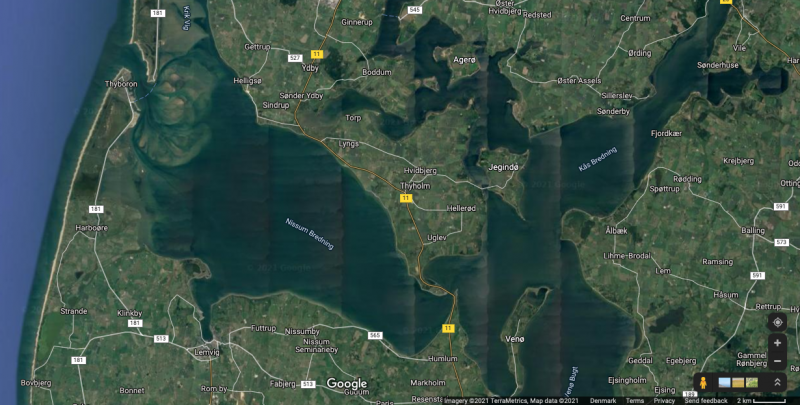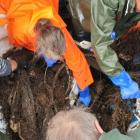One summer day in 2019, Kurt Svennevig Christensen and his friend decided to try a new spot for lobstering. They settled on Nissum Bredning, a large area of shallow water, at the westernmost part of Limfjorden, Denmark. Besides being a Special Area of Conservation, Nissum Bredning is known as a hotspot for catching crustaceans. To their horror, Kurt and his friend did not catch the desirable black lobsters that day. Instead, they found relics of motivated forgetting or symbols of human cruelty dressed as ignorance—the “catch” consisted of nothing but abandoned fishing equipment, popularly known as “ghost nets.”
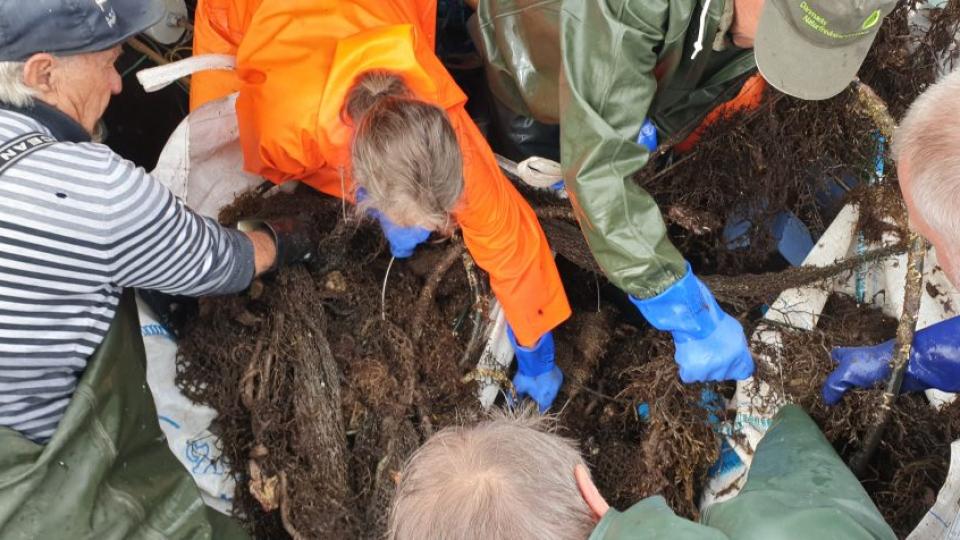
Bags of forgotten prisons.
Bags of forgotten prisons.
Levende Hav, 25 July 2020.
Accessed via the webpage of Levende Hav on 24 February 2022, click here to view source.
 This work is licensed under a Creative Commons Public Domain Mark 1.0 License.
This work is licensed under a Creative Commons Public Domain Mark 1.0 License.
Ghost nets are discarded fishing equipment that no longer has an owner. When gillnets, hooks, or trawls get caught in wrecks or reefs, the lines are cut, and material is left behind. The lost material will then carry on catching fish and other marine wildlife—sentencing them to eternal entrapment. The “specter” of the “ghost” net is that of an eternal, disembodied fisherman. Life is caught and lost in a past intention, like a submerged prison where the coordinates have been lost; life continues until starvation settles in and death strikes.
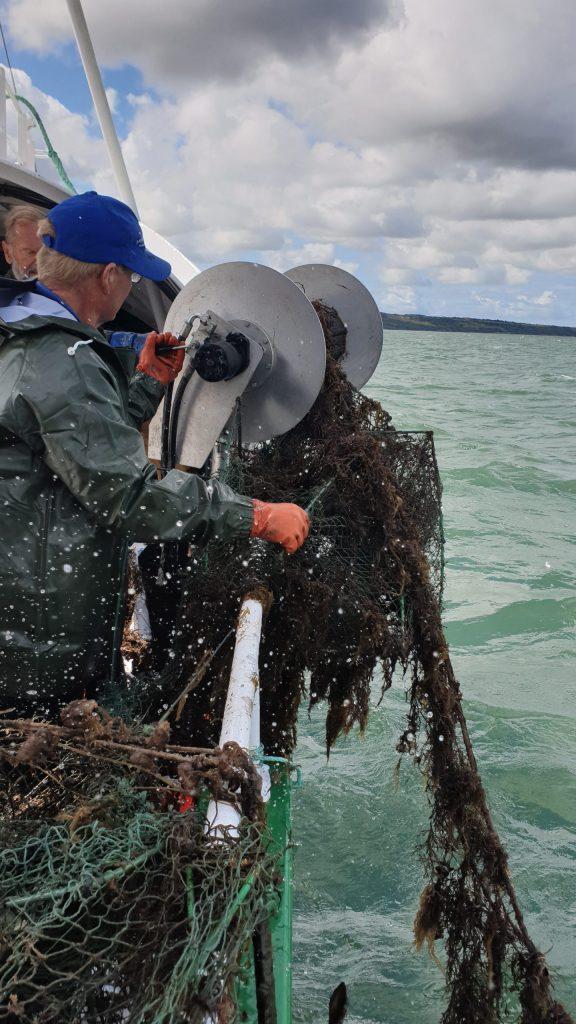
Bringing in a ghost net on the boat Anton.
Bringing in a ghost net on the boat Anton.
Levende Hav, 20 July 2020.
Accessed via the webpage of Levende Hav on 24 February 2022, click here to view source.
.
 This work is licensed under a Creative Commons Public Domain Mark 1.0 License.
This work is licensed under a Creative Commons Public Domain Mark 1.0 License.
However, not all life ends with death. As Kurt hauled the nets aboard, the stench of decomposition assaulted his nostrils. The processes of rot and decay denote that when one tide of life ebbs out, others come in; the crabs and lobsters were left dead in the nets, and microorganisms had begun their feast, breaking down what once was.
Ghosts and hauntings have recently entered the environmental humanities. Summoning these tropes, Anna Tsing et al. describe how human industry destroys the environment and life is sacrificed on the altar of growth and prosperity. Consequently, we are surrounded by ghosts as multiple pasts that return to haunt the present. The hauntings of the ghosts are exactly what surfaced and appeared to Kurt that day.
Ghost nets highlight several environmental concerns. Firstly, ghosts transgress quotas and regulations; despite the control of lobstering seasons and numbers, the nets are 24-7 tragedies, catching crustaceans regardless of restrictions. Secondly, most nets are plastics and exceed normal temporal conventions, releasing pollutant microplastics into the ocean during their eternal lifetime. Plastics’ very inexpensiveness promotes disposability. The submerged, abandoned nets invisibly contribute to the accumulative predicament of plastic pollution. Thirdly, besides the ethics of trapping and killing, the bycatch is enormous, and the deaths are both torturous and meaningless.
Kurt is the chair of a Danish NGO called “the Danish Society for a Living Sea” and well-respected in the international fishing community. Not only did the nets surprise him on that day in 2019, so did the staggering quantity. After inquiring with the local fishing milieu, he found that the ghost nets were well-known but unaddressed and unspoken of—a known unknown. The following year, Kurt and the society elected to take a straightforward approach. Thirty volunteers joined the NGO out on the fjord for three weeks to identify and collect as many nets as possible with their activist boat named Anton.

A claw caught in a ghost net.
A claw caught in a ghost net.
Levende Hav, 18 July 2020.
Accessed via the webpage of Levende Hav on 24 February 2022, click here to view source.
 This work is licensed under a Creative Commons Public Domain Mark 1.0 License.
This work is licensed under a Creative Commons Public Domain Mark 1.0 License.
The ghost nets are a general concern tied to wider phenomena such as global capitalism and the accumulation of cheap plastics, forming plastic gyres, harming large mammals and marine life. But in Nissum Bredning’s enclosed waters, there is additionally a “local haunting dynamics” at stake. Besides encountering approximately three hundred ghost nets, the society found the local habitat in a ghastly state. There is no cod, no sole, flounder, or plaice, as there used to be. Meanwhile, a severe decrease in lobster and the rise of the brown crab population signals imminent peril to the fjords’ ecosystem. Intensive fishing and the subsequent lack of fish to predate on the crabs has led to this unfortunate imbalance. The specter of the missing fish contributes to the manifestation of ghost nets in several crucial ways. In Nissum Bredning, the ghost nets are seldomly checked, leaving more time to trap lobsters and crabs. Usually, the nets catch fish, which die, and subsequently force the nets to the seabed, urging the fishers to check them frequently. With no fish to weigh them down, the ghost nets keep catching crustaceans for weeks and months. The ghost nets of Nissum Bredning, however, are intentionally neglected.
In time, the ghost nets become so filthy that the effort required to restore them surpasses the gain from collecting them and selling their catch. When inadvertently recuperated, precious lobster may be cut free, further deteriorating the worth of the net. Meanwhile, only the crabs’ claws are harvested because they are the only thing worthy of commodification. Torn limb from limb, the crabs’ dismembered bodies remain in their entangled prison. Finally, the nets are re-submerged and abandoned because both the nets and the clawless crabs are deemed worthless.
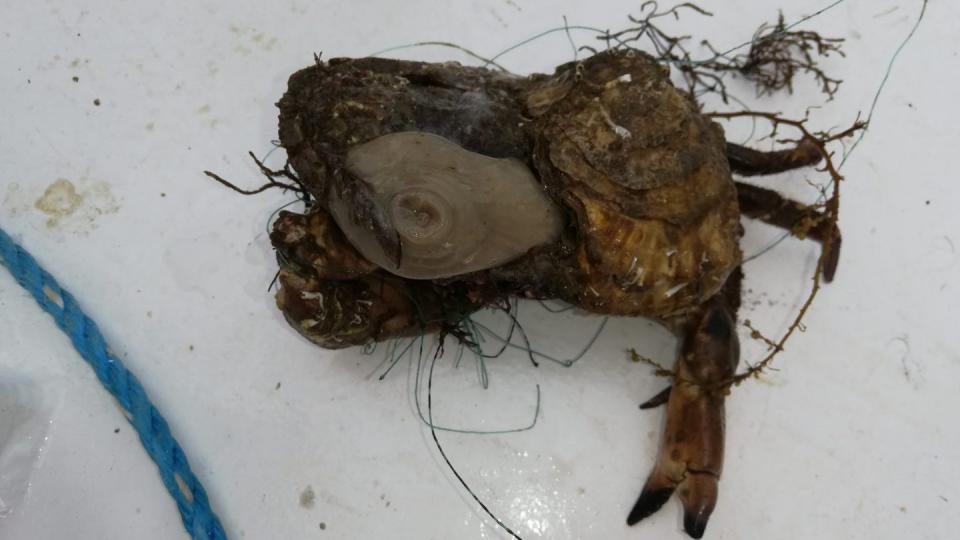
A sea anemone and an oyster has attached itself to a crab barely alive. The crab must have been trapped in the net for months.
A sea anemone and an oyster has attached itself to a crab barely alive. The crab must have been trapped in the net for months.
Levende Hav, 6 August 2020.
Accessed via the webpage of Levende Hav on 24 February 2022, click here to view source.
 This work is licensed under a Creative Commons Public Domain Mark 1.0 License.
This work is licensed under a Creative Commons Public Domain Mark 1.0 License.
Kurt and his friends at the Danish Society for a Living Sea continue to raise questions about ghost nets and the critical state of Nissum Bredning. The problem gained national media attention, and their efforts prompted a government project aimed at identifying and collecting derelict fishing gear. The Society is a lone but sturdy boat in a sea of concern pertaining to the issues of overfishing and pollution. Their actions serve as an example of how an activist approach can address a particular problem, bring it to attention, and initiate large-scale projects dedicated to a better and more living sea.
How to cite
Lundsteen, Sebastian. “Of Ghost Nets and the Haunting at Nissum Bredning.” Environment & Society Portal, Arcadia (Spring 2022), no. 3. Rachel Carson Center for Environment and Society. doi:10.5282/rcc/9392.
ISSN 2199-3408
Environment & Society Portal, Arcadia
 This work is licensed under a Creative Commons Attribution 4.0 International License.
This work is licensed under a Creative Commons Attribution 4.0 International License.
2022 Sebastian Lundsteen
This refers only to the text and does not include any image rights.
Please click on the images to view their individual rights status.
- Anderson, Michael C., and Simon Hanslmayr. “Neural Mechanisms of Motivated Forgetting.” Trends in Cognitive Sciences 18, no. 6 (2014): 279–92. https://doi.org/10.1016/j.tics.2014.03.002.
- Egekvist, Josefine, Finn Larsen, and Lars O. Mortensen. Ghost Nets: A Pilot Project on Derelict Fishing Gear. Lyngby: Danmarks Tekniske Universitet, 2017.
- Henriksen, Line. “Ecohauntology.” Critical Posthumanism Network (blog). Accessed 20 May 2021. https://criticalposthumanism.net/ecohauntology/.
- Tsing, Anna Lowenhaupt, Heather Anne Swanson, Elaine Gan, and Nils Bubandt. Arts of Living on a Damaged Planet, Ghosts of the Anthropocene, Monsters of the Anthropocene. Minneapolis: University of Minnesota Press, 2017.


